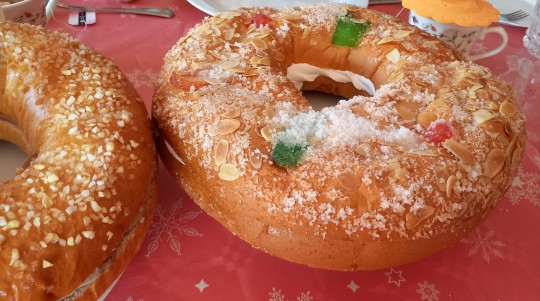#roscon de reyes
Text

Does anyone other than Spain have roscon??
7 notes
·
View notes
Photo

✿ ロスコン・デ・レジェス | Roscon de Reyes
・スペインのクリスマスのお菓子。「王様のケーキ」と訳されているスペインの甘いパン。ドーナツ型の生地に砂糖漬けしたフルーツやナッツが散りばめられたケーキで、1月6日の公現祭(3名の賢者がキリストの誕生を祝福した日)に食されます。ケーキの中には陶器の人形や豆が入っており、前者は幸運が訪れ、後者はロスコンの代金を支払わなければならないルールがあるそう。
#roscón de reyes#roscon de reyes#ロスコン・デ・レジェス#ロスコンデレジェス#sweets:スペイン#スペイン:パン#スペイン:菓子パン#菓子パン#パン#1月6日#season:1月#公現祭#スペイン#スペイン:クリスマス#season:クリスマス#world:クリスマス#2020〜#果物#スペイン:果物
3 notes
·
View notes
Text
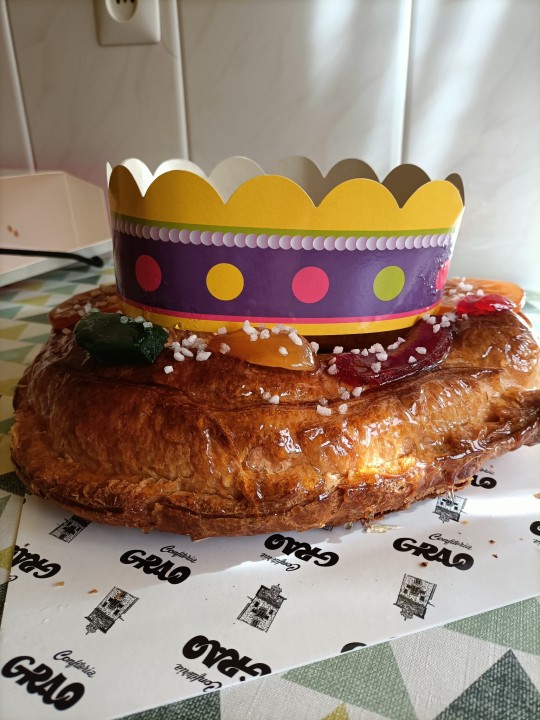

Feliz día de Reyes.
Os deseo un delicioso Roscón de Reyes para todos.
#Día de Reyes#Roscon de Reyes#for the record: la figurita me tocó a mí. Así que la corona es míaaasaa
5 notes
·
View notes
Text
@ Spanish people

1 note
·
View note
Text
Who do I have to kill to get candied cherries in this God forsaken town. December 6th is tomorrow and I'm making the Roscon de Reyes, I'm going to make a fool of myself.
12 notes
·
View notes
Text
Cold winter: Los Reyes Magos
LOS REYES MAGOS
Category: Spanish folklore / Christmas season / Biblical lore
In Spain, children don’t wait eagerly for Christmas. Christmas is a big holiday for adults, not for them! They don’t get any presents on Christmas… No, they only get presents during the other big holiday of the winter season. Not Christmas, not New Year… But the Epiphany, also known as “El dia de los Reyes” (The day of the Kings). And they don’t get their presents from any Santa or Saint Nicholas – but from Los Reyes Magos, The King-Magi – or those that the English like to call “The Three Wise Men”.
Everybody knows the story… After the birth of Jesus in Bethlehem, three “wise men” (not actually but more about that later) came from the east to Judea, and asked king Herod to see the child that had been born “king of the Jews”, explaining that they knew he was here for they followed his “star” in the night sky, and came to pay homage. King Herod, who had tried to kill baby Jesus before, then sent the three wise men to search the baby on their own, but told them to come return to him afterward so he could too “pay homage” to the “king of the Jews”. Following the rising star, the three wise men finally found where baby Jesus was – and they all kneeled before him and his family, offering three gifts: gold, frankincense and myrrh. But a dream warned them not to return to Herod or inform him about the child’s location, so after they paid their homage they “returned to their country by another path”.
In Spain, the Epiphany is a grand celebration of the Magi : they are the ones supposed to bring gifts to children on the night of the Epiphany (and the children notably have to send letters to the three Kings to explain their desires, just like with Santa). Each Epiphany Day great and colorful parades are organized throughout the town (called the cabalgatas de los reyes mmagos or cavalcades of the Magi), welcoming the three Kings as they throw candies and goodies at the audience: Melchior from Europe (or Arabia depending on the tradition), Gaspar from Asia, and Balthazar from Africa. Coming from the East while riding camels, they then proceed during the night (or the eve’s night) to visit each household, leaving gifts for the children in their polished shoes. In exchange, the children leave some food and drinks for both the Kings and their camels – sweet wine, fruits, milk, dried grass and hay… If the child was good, they will receive a gift – but if the child was bad, they will receive coal (though, just like with the Befana’s tradition, the coal was promptly replaced by a form of black candy called “sweet coal”). There is also a specific cake for the Epiphany, called the “Roscon de Reyes” (accents not included), a brioche-like cake with orange blossom water for the taste. It is in the shape of a circle, to mimic a crown, and has as “jewels” candied or crystalized fruits. Usually filled with cream (though some are “plain” without filling, while others prefer chocolate cream or whipped cream), it also contains a small figurine shaped like one of the Reyes Magos, and dried bean. Whoever gets the slice with the figurine is crowned the “king” or “queen” for the day, and is ensured to have good luck for the year ; however the one that gets the bean will have to pay for the cake.
I want to return on what I said before… the fact that the three Kings come from three different continents. It is a tradition that exists outside of Spain, and for quite a long time. In fact it was a tradition started by medieval art, and then reused by Renaissance art heavily – before being picked up by folk traditions such as the Epiphany holidays. This tradition insists on having the three Magi correspond to the three parts of the world (as they were known in the Middle-Ages, and before the discovery of America, “the fourth continent”). Hence the separation above and the idea that the Three Kings were white, oriental and black – to represent how the powerful kings of the entire world came kneeling down in front of Jesus. But this tradition tends to overlap with another one… another habit that rather has the three Kings represent the three ages of men, one being old, the other middle-age, and the last young. Sometimes the two depictions are separate, other times they overlap – and the last case is fascinating because the choice of superposition is not innocent. In this overlap, Melchior the European will be depicted as an old man, because in medieval (and Renaissance) ideas, Europe was the “old civilization” and the “father” of all things. Meanwhile, Balthazar of Africa will be depicted as a young man, because in medieval and Renaissance mindsets Africa was a “child” continent with barely any civilization (and if you told them Africa had a much older history than Europe they would have laughed in your face). Gaspar the Asian is usually the middle-aged one.
But this tradition of the “symbolism of three” actually comes from art and folk traditions – I want to insist on this. It is not a religious tradition, because for religious authorities and the “actual” Christian culture (pushing aside all local traditions), the three wise men don’t come from just anywhere in the world. They come from the East, the text is pretty clear.
But before that, let’s take a look at the actual title of these guys… People call them the “three wise men”. Wrong translation. Or an oversimplified one. People call them the “Three Kings” and the “Three Magi”, and this is half-right, because they are “king-magi”. The “king” part is pretty obvious, but the “Magi” part might be more obscure to people today. “magi” is the plural of “magus” which, yes, is the origin of “mage” and with time came to mean “sorcerer” (the New Testament several times use the term “magi” to designate sorcerer and male witches, like Simon the Mage or Elymas). But here, “magus” has to be understood in its original sense: the Greek transliteration of the Old Persian “magus”, which is actually a term designating the priesthood of Zoroastrianism. The Zoroastrian priests were most notably renowned as astronomers, because their study and religious practices demanded that they knew and observed the starts and the constellations (hence the whole “we followed a star to find the babe”). And, due to being both priests and astronomers, the “magi” came to be seen and perceived as men dabbling in the “occult” or men of many high and intellectual crafts – hence the evolution into “wise men” and “sorcerers”, and how from “priesthood-rulership” the “three magi kings” turned into “knowledgeable kings dabbling into astronomy”. That, coupled with them “coming from the East”, came to people identifying them as kings from the Parthian Empire, which stretches from Syria to India, and had Zoroastrianism as a dominant religion.
The most well-known and agreed “origins” of the three “scholar-kings” in religious traditions has a given set of countries: Persia for Melchior; India for Caspar (or Gaspar or Jaspar), Arabia for Balthasar (or Balthazar), though he is sometimes rather given Ethiopia as a kingdom. But there is another one, which overlaps with the “three ages of man” depictions, that rather claims that Caspar was the old one and “king of Tarsus” (a land on the southern coasts of today’s Turkey), Melchior was the middle-aged ruler of Arabia, and Balthazar the young man coming from Saba (today’s northern Yemen).
Similarly, which magus gave which gift to baby Jesus is a big subject of debates – but everyone agrees on the fact that there were three gifts. Gold, frankincense and myrrh. The meaning of these gifts has also been heavily debated. Some people invoke that, very simply, it just are very valuable, very rare gifts, precious enough to be worthy of a king – myrrh being a precious body oil, frankincense a type of perfume, and gold being gold. These people hold that the gifts should merely be interpreted as “gifts for a newborn king”. But another group rather wants to see in those gifts three symbols reflecting Jesus’ life, and his nature as the Christ. Indeed, “gold” would mean a form of material power and wealth, and reflect an earthly kingship, while frankincense (which is used as incense) would reflect a type of worship and prayers, and mean a divine nature (as Jesus is the “son of god”). As for the myrrh… it was used as an embalming oil, and would represent death – either the mortal nature of this son of God, or his foretold death at the cross, a crucifixion needed to redeem all of humanity. This is notably associated with a famous sentence “Gold, as to a king ; myrrh, as to one who was mortal ; and incense, as to a God”. (A “softer” interpretation in this sense rather invokes gold as symbolizing a great, pure virtue ; frankincense as representing a strong faith and solid prayers, while myrrh is here to symbolize the suffering of a mortal life).
- - - - - -
Unfortunately, in modern urban areas of Spain, the tradition of the Reyes Magos as gift-givers tends to be replaced by the much more well-known and widespread Santa Claus.
But I want to add one thing about the “Magi-Kings”. I talked about the folkloric and artistic tradition. I talked about the religious tradition. However, what about the original text? It is fascinating to look at the actual text that speaks of them, only one of the four Gospels, Matthew’s Gospel. Because… well most of what we “know” or believe about this trio isn’t in there.
For example yes, the three wise men come from the east… But the text never specifies that they were three. This idea came from the fact the magi came bearing three gifts – but nowhere in the text are they said to be three. (In fact early traditions and depictions spoke of two, four of five magi). Similarly, the names “Gaspar, Balthazar and Melchior” aren’t in the New Testament. They were “found” or “invented” later, in posterior texts. In fact some local churches give them different names: the Ethiopian Church, one of the oldest branches of Christianity in the world, calls them “Hor”, “Karsudan” and “Basanater”. And let’s tackle another myth: “reyes” magos ; “rois” mages ; “king” magi… The text never specifies that they were kings. The text only speaks of “magi”. Nowhere are they king. So where does it comes from? Well, this idea comes from the Old Testament, not the New, where a prophecy/vision describes the future upcoming Messiah (identified by Christians as Jesus) as being worshipped by kings upon his birth… Which the Christians promptly related to the scene of the “Adoration of the Magi”, when the magi kneeled in front of young Jesus bearing their gifts. And so bam! From just astrologer-priests, they became kings!
#cold winter#the three wise men#epiphany#los reyes magos#the three magi#the three kings#christian lore
4 notes
·
View notes
Text
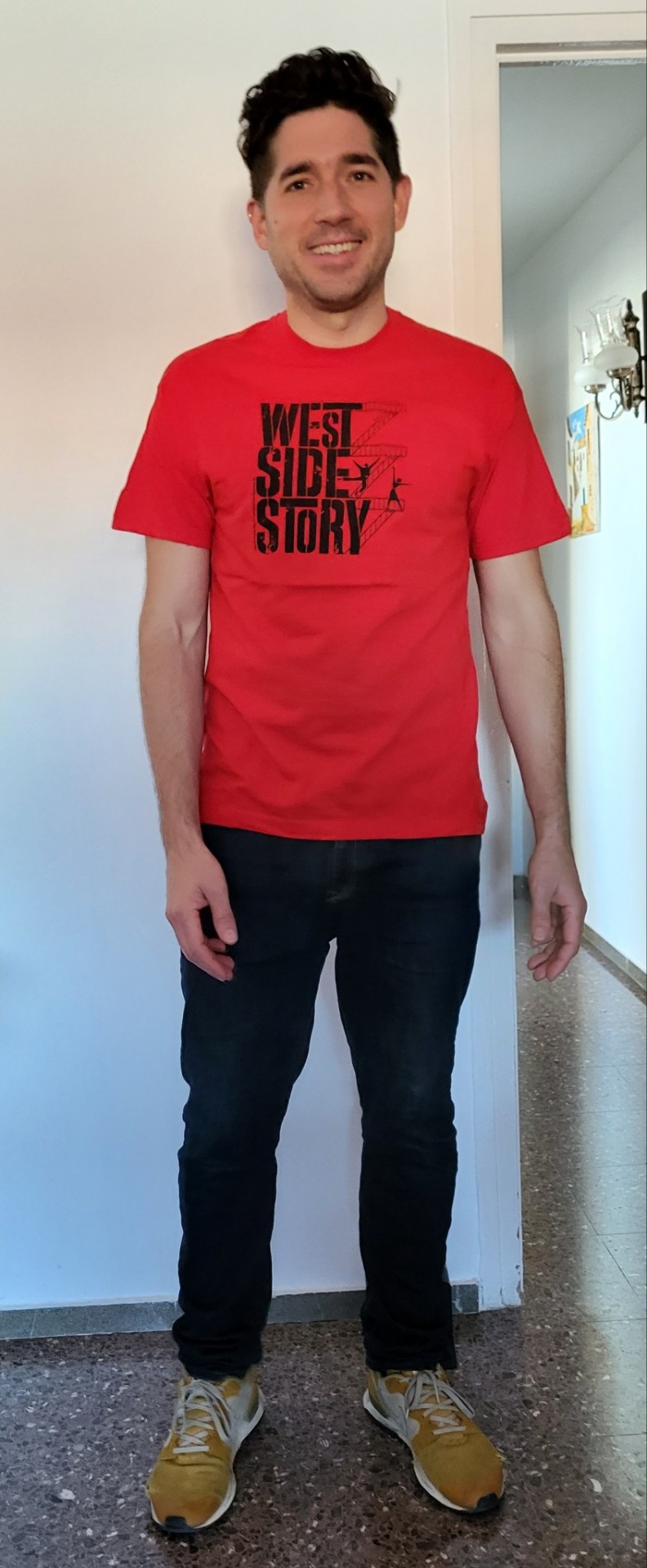

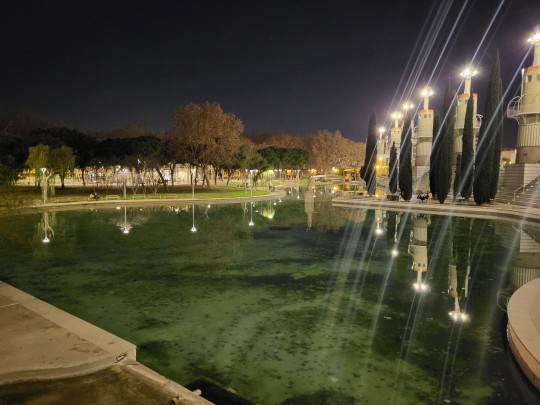
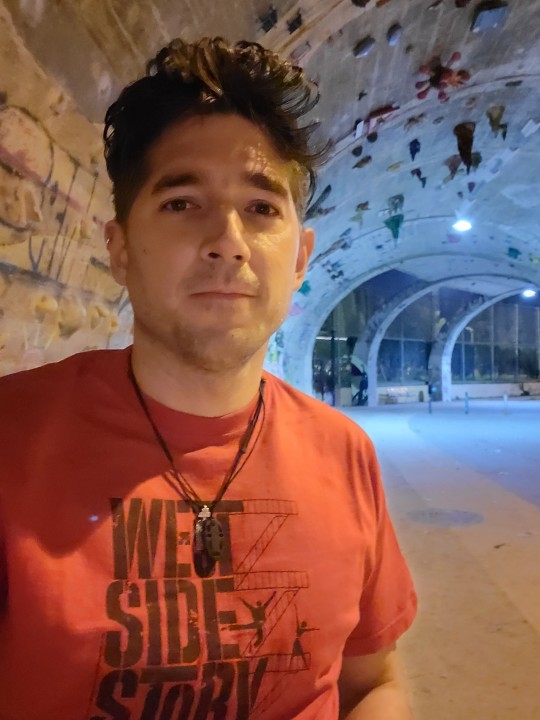
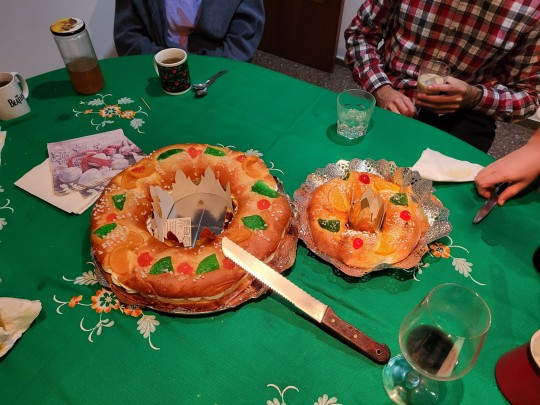





Winter holiday recap part 4 (and last)
Taping auditions with the help of my sister, first time they ask me for a picture of my back
Meeting for dinner with Joan (already mentioned how he made me feel bad as he can so easily do, feeling much better about it)
Going to Cornella to meet with Mari, visiting the dying mall, walking and talking about race politics and political correctness. I love how she instantly makes me feel like I never left.
I wanted to use the transbordo but I can't, so I jump in the tram towards Maria Cristina without paying. Have to jump out in a rush in L'illa Diagonal when a ticket agent and a security guard enter the tram. My heart beat is flying. I feel stupid. I'm not 20 anymore, who does that?
Walk from there to La Foixarda and climb a bit by myself, then call my sister and talk to her while walking back to Plaza Espanya
Going shopping with my siblings for Reyes, my sister never shows up
I only eat two pieces of Roscon because all this time I've been trying to control my sugar intake since the doctor told me on my last physical that I was pre-diabetic
I would usually eat at least four and big ones
go to Barbera to hand with Marina for a bit before going to see Marc and Marina
We hike in this area where there are rocks with weird shapes
we have pizzas and play a zombie survival board game that is all about team effort. Marina struggles with having to do what's best for the team instead of what she wants to do herself, she is very independent
that makes me veeeeeeery late to meet Juan Luis and Jaume, I'm not a great friend
I am driven to Badalona by Marc's nice friend Javi (otherwise I would have never made it)
We eat pizza, again, at the place where they sell it by the meter
it smells horribly of tobacco
Juan Luis tells me about his various ailments while Jaume is a bit off, maybe he's not ecstatic that I'm late
They drive me home
More auditions
The last day before leaving we take the car and go up to Vilassar de Mar, to take advantage of the nice sun
a very nice bar owner let's us eat some things even though they just closed the kitchen, we have great fried artichokes
we take a selfie using a public stand erected by the town government for that purpose
The next day I wake up at 6am to go get the subway, then the subway, then the train, then the shuttle, then a plane to Munich, then a plane to Miami, then the airplane train, a metro rail train, a metro mover, to do it all in reverse the next morning to go back to the airport and then a plane to Atlanta.
The next day I get a rental to drive to Tallahassee for the FSU thesis films (but I've already talked about it)
Okay, I've rambled enough. Today is my sister's birthday. She came with the spring. Felicidades Ana!
6 notes
·
View notes
Text



https://pane-bistecca.com/2023/01/05/drei-konigs-kuchen-galette-des-rois-roscon-rosca-des-reyes-bolo-rey-kings-cake/
#drei koenigs kuchen#three kings cake#three kings day#drei koenigs tag#cake#bread#kuchen#brot#snack#gebaeck#fruehstueck#breakfast
4 notes
·
View notes
Text
Time to start thinking of my holiday baking!
This is made more difficult by the fact that my husband can’t eat butter, cream or anything high fat (which sadly is most delicious Christmas desserts). But I will attempt my best to make him happy this year along with making my favourite treats.
Ideas so far:
Orange cranberry muffins
Gluten free/oil free sugar cookies (I’ve never made these, they use almond flour instead of butter and I’m curious if it will work)
Cinnamon rolls
Eggnog? (Anyone have a good non-alcoholic version?)
Peppermint merengues
Cranberry orange cake, maybe with almonds on top
Roscon de Reyes
Ideas specifically for me/as gifts:
Gingerbread (I want to try Toco’s German/Prussian type)
Caramels (I make these every year)
Shortbread cookies
3 notes
·
View notes
Text
Roscón de Reyes: ¿qué significan el haba y las figuras?
https://celebramomentos.com/roscon-de-reyes-que-significan-el-haba-y-las-figuras/
Roscón de Reyes: ¿qué significan el haba y las figuras?
¿Alguna vez te has preguntado qué significan el haba y las figuras del típico Roscón de Reyes? ¡No te preocupes, es algo común entre muchas personas! Esta tradición es uno de los elementos centrales de las celebraciones de la Navidad en España. Este delicioso pastel es uno de los alimentos más populares en estas fechas, … Leer más » https://celebramomentos.com/roscon-de-reyes-que-significan-el-haba-y-las-figuras/
0 notes
Text
Alicante Gastronómica Solidaria elabora 1.000 roscones para distribuir a colectivos vulnerables y personas sin recursos
Cámara Solidaria-AlicanteGastronómica Solidaria (AGS) elaborará y distribuiráen la Noche y el Día de Reyes 1.000 roscones individualesjunto con los menús de esas fechas entre los colectivos más vulnerables y personas sin hogar de la provincia de Alicante. Un menú que para esos días está compuesto por el tradicional gazpacho manchegoacompañado de un refresco de ‘Coca-Cola’, una ensalada especial…

View On WordPress
0 notes
Text
gonna try and bake a roscon de reyes this year because the only one i could find at stores is gluten free and i am NOT putting my loved ones through that
#i did it one year ageesssss ago and it came out so good#sorry to celiac people but gf bakery is a hit or miss and most times is a miss lol
1 note
·
View note
Text
The Peninsula Manila Celebrates The Feast of the Three Kings

The Peninsula Manila brings the holiday season to a magical close with the Celebration of the Feast of the Three Kings! On January 6, 2024, from 11:00 am to 12:00 noon, the Three Kings will visit The Peninsula Manila, bringing with them presents for children. There will be special celebrations starting with a parade around the hotel bringing the Three Kings from the East — Melchior, Gaspar and Balthazar — to The Lobby before proceeding to Escolta restaurant where a delicious buffet lunch awaits guests from 12:00nn to 2:30pm at P3,000 nett per person. The Feast of the Three Kings is also a time for indulging one’s sweet tooth. Visit The Peninsula Boutique for a taste of Roscon de Reyes (P990), a traditional Spanish brioche-like sweet bread that represents the three kings’ crowns that’s eaten on the Feast of the Three Kings which celebrates Epiphany when the Three Kings came to visit the baby Jesus in Bethlehem.
For inquiries or further information on The Peninsula Manila’s Celebration of the Feast of the Three Kings in Escolta, please call +63 (2) 887-2888, extensions 6691 and 6694, e-mail [email protected] or visit peninsula.com.
0 notes
Text

Rainy day celebrations yesterday for boyfriend’s birthday with vegetable stew and Roscon de Reyes at Little Bread Pedlar; red mullet, courgette and tomato pasta with garlic and chilli for supper.
0 notes

